The railway CNC wheel lathe market is expected to reach USD 481.6 million in 2025 and expand to USD 719.8 million by 2035, reflecting a compound annual growth rate (CAGR) of 4.1%. This growth reflects the increasing need for precision wheel maintenance in rail transport, driven by rising investments in railway infrastructure and modernization initiatives. CNC wheel lathes play a critical role in improving the efficiency and accuracy of wheel reprofiling, ensuring safety, reliability, and extended service life of rolling stock. As global rail networks expand and upgrade, demand for advanced maintenance equipment is expected to grow steadily. The market trajectory underscores the importance of CNC technology in supporting sustainable and efficient railway operations worldwide.
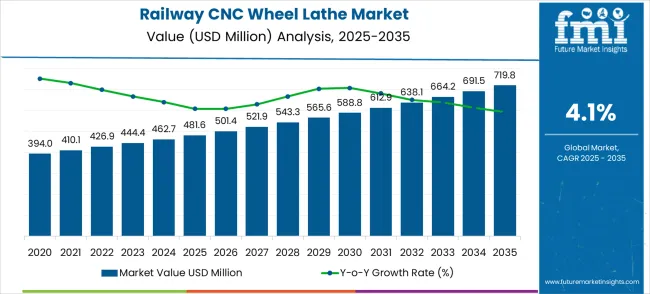
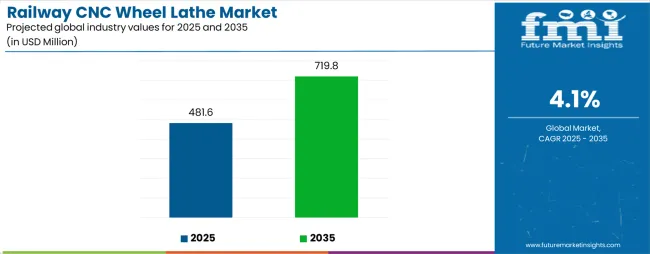
A central factor influencing this market is the focus on minimizing downtime and optimizing maintenance cycles. Year-on-year (YoY) growth shows a steady upward progression, with values increasing from USD 394.0 million in 2023 to USD 481.6 million in 2025, and continuing upward across the forecast period. CNC wheel lathes provide consistent machining quality, reduce human error, and lower overall operating costs for railway maintenance facilities. Partnerships between lathe manufacturers and railway operators are fostering greater adoption of these systems. Additionally, advancements in software automation, digital monitoring, and integration with predictive maintenance tools are further strengthening the case for CNC wheel lathes as essential assets in modern railway workshops.
Looking ahead, the railway CNC wheel lathe market is expected to maintain moderate growth, with values reaching USD 588.8 million by 2030 and eventually USD 719.8 million by 2035, at a CAGR of 4.1%. Peak-to-trough analysis indicates limited volatility, with growth remaining consistent across the forecast period due to the stable nature of railway maintenance demand. While occasional fluctuations may occur due to infrastructure investment cycles and procurement budgets, the overall trend remains steadily upward. This reflects the non-negotiable requirement of wheel maintenance for operational safety and efficiency. The market outlook highlights a long-term, sustainable opportunity, where technological enhancements and the global push for reliable rail transport continue to drive steady adoption of CNC wheel lathes.
| Metric | Value |
|---|---|
| Estimated Value in (2025E) | USD 481.6 million |
| Forecast Value in (2035F) | USD 719.8 million |
| Forecast CAGR (2025 to 2035) | 4.1% |
Market expansion is being supported by the increasing global demand for railway infrastructure modernization and the corresponding shift toward automated maintenance solutions that can provide superior precision and efficiency while meeting industry requirements for reliable and cost-effective rail maintenance operations. Modern railway operators and maintenance facilities are increasingly focused on incorporating CNC wheel lathes to enhance maintenance capabilities while satisfying demands for improved wheel profile accuracy and reduced maintenance downtime. Railway CNC wheel lathes' proven ability to deliver superior machining precision, operational efficiency, and maintenance reliability makes them essential equipment for modern rail maintenance facilities and railway depot operations.
The growing emphasis on railway safety and operational efficiency is driving demand for high-quality railway CNC wheel lathe products that can support distinctive maintenance capabilities and premium equipment positioning across passenger rail, freight rail, and urban transit categories. Equipment manufacturer preference for systems that combine machining excellence with automation capabilities is creating opportunities for innovative CNC wheel lathe implementations in both traditional rail maintenance and emerging high-speed rail applications. The rising influence of predictive maintenance and Industry 4.0 technologies is also contributing to increased adoption of premium railway CNC wheel lathe products that can provide authentic high-performance rail maintenance characteristics.
The market is segmented by machine configuration, application, and region. By machine configuration, the market is divided into CNC underfloor wheel lathe and CNC above-floor wheel lathe. Based on application, the market is categorized into passenger rail and freight rail. Regionally, the market is divided into North America, Europe, East Asia, South Asia & Pacific, Latin America, and the Middle East & Africa.
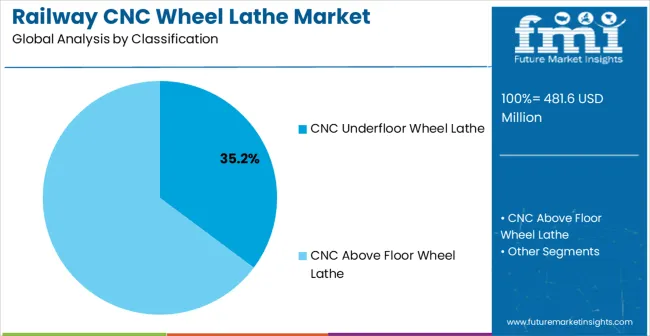
The CNC underfloor wheel lathe segment is projected to account for 35.2% of the railway CNC wheel lathe market in 2025, reaffirming its position as the leading machine configuration category. Railway maintenance facilities and depot operators increasingly utilize underfloor wheel lathes for their superior accessibility characteristics, efficient workflow integration, and space optimization capabilities across diverse rail maintenance applications. Underfloor wheel lathe technology's specialized installation design and operational efficiency directly address the facility requirements for streamlined maintenance processes and effective space utilization in railway maintenance depot operations.
This machine configuration segment forms the foundation of modern rail maintenance applications, as it represents the technology with the greatest operational efficiency and established facility compatibility across multiple railway maintenance systems. Manufacturer investments in underfloor design optimization and automation enhancement continue to strengthen adoption among railway depot operators. With maintenance facilities prioritizing operational efficiency and space optimization, CNC underfloor wheel lathes align with both productivity objectives and facility management requirements, making them the central component of comprehensive rail maintenance strategies.
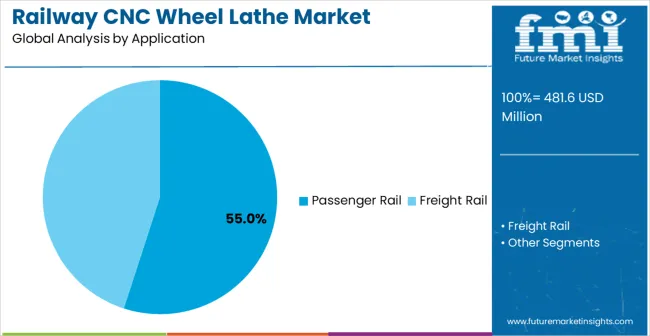
Passenger rail applications are projected to represent 55% market share of railway CNC wheel lathe demand in 2025, underscoring their critical role as the primary application for precision wheel maintenance in passenger train operations and high-speed rail systems. Railway operators prefer CNC wheel lathes for their exceptional precision capabilities, safety compliance characteristics, and ability to maintain consistent wheel profiles while supporting passenger service reliability requirements during rail operations. Positioned as essential equipment for high-performance passenger rail maintenance, CNC wheel lathes offer both safety assurance and operational efficiency advantages.
The segment is supported by continuous growth in passenger rail services and the growing availability of specialized maintenance technologies that enable enhanced safety performance and service quality optimization at the operational level. Additionally, passenger rail operators are investing in advanced maintenance technologies to support service reliability and safety compliance. As passenger rail continues to expand and operators seek superior maintenance automation solutions, passenger rail applications will continue to dominate the application landscape while supporting safety advancement and operational efficiency strategies.
The railway CNC wheel lathe market is advancing steadily due to increasing railway infrastructure investments and growing demand for automated maintenance solutions that emphasize superior precision and efficiency across passenger rail and freight rail applications. However, the market faces challenges, including high equipment costs compared to traditional maintenance alternatives, technical complexity in installation and operation, and limited skilled technician availability for advanced CNC systems. Innovation in automation enhancement and user-friendly operation continues to influence market development and expansion patterns.
The growing adoption of railway CNC wheel lathes in high-speed rail and urban transit applications is enabling equipment manufacturers to develop systems that provide distinctive precision capabilities while commanding premium positioning and enhanced performance characteristics. Advanced applications provide superior wheel profile accuracy while allowing more sophisticated maintenance development across various rail transport categories and service segments. Manufacturers are increasingly recognizing the competitive advantages of precision maintenance positioning for premium equipment development and high-performance rail market penetration.
Modern railway CNC wheel lathe suppliers are incorporating smart maintenance technologies, predictive analytics systems, and remote monitoring capabilities to enhance maintenance efficiency, improve equipment reliability, and meet railway demands for intelligent and proactive maintenance solutions. These programs enhance operational performance while enabling new applications, including predictive maintenance scheduling and automated quality control systems. Advanced technology integration also allows suppliers to support premium market positioning and maintenance innovation leadership beyond traditional commodity machining equipment.
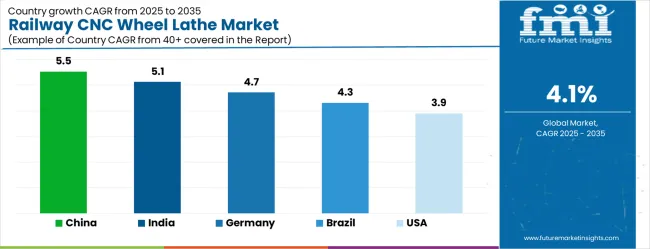
| Country | CAGR (2025-2035) |
|---|---|
| China | 5.5% |
| India | 5.1% |
| Germany | 4.7% |
| Brazil | 4.3% |
| U.S. | 3.9% |
| U.K. | 3.5% |
| Japan | 3.1% |
The railway CNC wheel lathe market is experiencing robust growth globally, with China leading at a 5.5% CAGR through 2035, driven by the rapidly expanding high-speed rail network, massive investments in railway infrastructure, and increasing adoption of advanced rail maintenance technologies. India follows at 5.1%, supported by growing railway modernization, rising infrastructure investments, and expanding urban transit capabilities. Germany shows growth at 4.7%, emphasizing advanced engineering technology and premium rail maintenance solutions. Brazil records 4.3%, focusing on emerging rail infrastructure applications and transportation development. The U.S. demonstrates 3.9% growth, prioritizing rail infrastructure modernization and innovation in maintenance. The U.K. exhibits 3.5% growth, supported by rail network development and advanced maintenance capabilities. Japan shows 3.1% growth, emphasizing precision manufacturing excellence and high-quality rail maintenance equipment production.
The report covers an in-depth analysis of 40+ countries top-performing countries are highlighted below.
The railway CNC wheel lathe market in China is anticipated to witness significant growth with a CAGR of 5.5% through 2035, driven by the rapidly expanding high-speed rail network and massive government investments in railway infrastructure development across major transportation corridors. The country's growing rail maintenance capacity and increasing adoption of advanced CNC technologies are creating substantial demand for precision wheel maintenance equipment in both established and emerging rail applications. Major rail equipment manufacturers and maintenance companies are establishing comprehensive production and service capabilities to serve both domestic infrastructure needs and export markets.
Revenue from railway CNC wheel lathes in India is expanding at a CAGR of 5.1%, supported by growing railway modernization, increasing infrastructure investments, and expanding urban transit applications. The country's developing rail infrastructure and expanding maintenance capabilities are driving demand for efficient maintenance equipment across both existing network upgrades and new rail construction applications. International rail equipment companies and domestic manufacturing specialists are establishing comprehensive distribution and service capabilities to address growing market demand for advanced rail maintenance solutions.
Demand for railway CNC wheel lathes market in Germany is projected to grow at a CAGR of 4.7% through 2035, driven by the country's advanced rail technology sector, premium maintenance equipment manufacturing capabilities, and leadership in precision engineering solutions. Germany's sophisticated railway system and willingness to invest in high-performance maintenance equipment are creating substantial demand for both standard and specialized CNC wheel lathe varieties. Leading technology companies and rail equipment manufacturers are establishing comprehensive innovation strategies to serve both European markets and growing international demand.
Demand for railway CNC wheel lathes market in Brazil is projected to grow at a CAGR of 4.3% through 2035, supported by the country's expanding rail infrastructure, growing transportation applications, and increasing adoption of modern maintenance technologies requiring efficient rail maintenance solutions. Brazilian rail operators and international companies consistently seek reliable maintenance equipment that enhances operational efficiency for both freight transportation and passenger service markets. The country's position as a regional transportation hub continues to drive innovation in rail maintenance applications and operational standards.
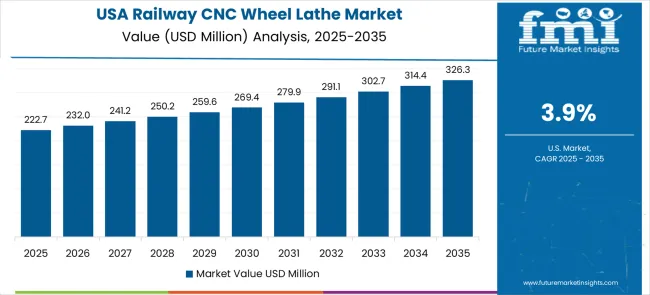
Revenue from railway CNC wheel lathes in the United States is projected to grow at a CAGR of 3.9% through 2035, supported by the country's advanced rail infrastructure sector, maintenance technology innovation capabilities, and established leadership in transportation solutions. American rail operators and equipment manufacturers prioritize safety, reliability, and efficiency, making CNC wheel lathes essential equipment for both freight rail operations and the development of passenger services. The country's comprehensive rail infrastructure and technical expertise support continued market development.
Railway CNC wheel lathes in the United Kingdom is projected to grow at a CAGR of 3.5% through 2035, supported by the country's rail network development sector, advanced maintenance capabilities, and established expertise in transportation solutions. British rail operators' focus on service reliability, safety, and operational excellence creates steady demand for reliable CNC wheel lathe equipment. The country's attention to maintenance quality and network optimization drives consistent adoption across both traditional rail services and emerging high-speed applications.
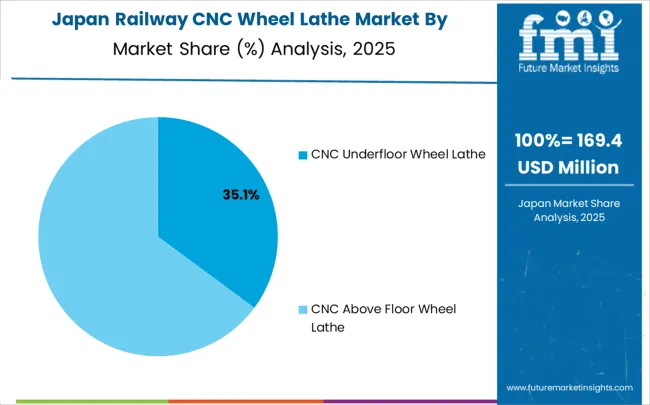
Railway CNC wheel lathes market in Japan is projected to grow at a CAGR of 3.1% through 2035, supported by the country's precision rail manufacturing excellence, advanced maintenance technology expertise, and established reputation for producing superior rail equipment while working to enhance maintenance efficiency capabilities and develop next-generation rail technologies. Japan's rail industry continues to benefit from its reputation for delivering high-quality transportation equipment while focusing on innovation and precision engineering.
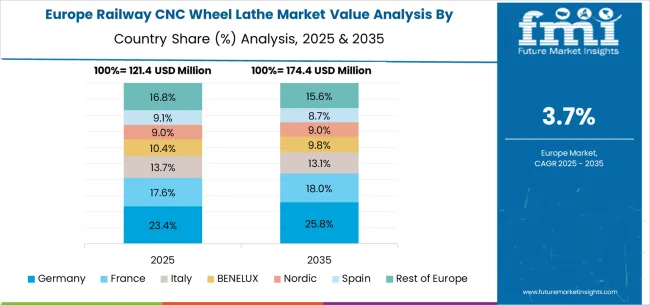
The railway CNC wheel lathe market in Europe is projected to grow from USD 125.4 million in 2025 to USD 178.4 million by 2035, registering a CAGR of 3.6% over the forecast period. Germany is expected to maintain its leadership position with a 28.9% market share in 2025, remaining stable at 28.7% by 2035, supported by its advanced rail technology sector, precision maintenance equipment manufacturing industry, and comprehensive innovation capabilities serving European and international markets.
The United Kingdom follows with a 19.7% share in 2025, projected to reach 19.9% by 2035, driven by rail network development programs, advanced maintenance capabilities, and growing focus on precision rail maintenance solutions for premium applications. France holds a 17.4% share in 2025, expected to maintain 17.2% by 2035, supported by high-speed rail demand and advanced transportation applications, but facing challenges from market competition and infrastructure investment considerations. Italy commands a 13.8% share in 2025, projected to reach 14.0% by 2035, while Spain accounts for 10.6% in 2025, expected to reach 10.8% by 2035. The Netherlands maintains a 5.2% share in 2025, growing to 5.3% by 2035. The Rest of Europe region, including Nordic countries, Eastern Europe, Belgium, Switzerland, and Austria, is anticipated to hold 15.6% in 2025, declining slightly to 15.3% by 2035, attributed to mixed growth patterns with moderate expansion in some advanced rail markets balanced by slower growth in smaller countries implementing rail infrastructure development programs.
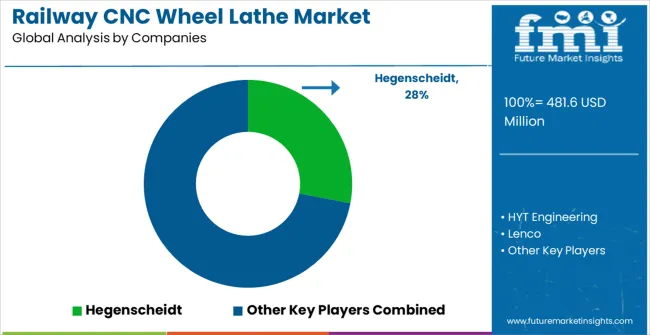
The railway CNC wheel lathe market is characterized by competition among established rail equipment companies, specialized CNC machinery manufacturers, and integrated maintenance solution suppliers. Companies are investing in advanced CNC technologies, precision engineering systems, application-specific equipment development, and comprehensive technical support capabilities to deliver consistent, high-precision, and reliable railway wheel lathe products. Innovation in automation enhancement, precision optimization, and customized rail maintenance solutions is central to strengthening market position and customer satisfaction.
Hegenscheidt leads the market with a strong focus on rail maintenance innovation and comprehensive wheel lathe solutions, offering sophisticated CNC wheel lathe products that emphasize precision assurance and operational excellence. HYT Engineering provides specialized rail equipment capabilities with a focus on maintenance applications and international rail networks. Lenco delivers advanced CNC technology with a focus on innovation and premium equipment development. WMT CNC specializes in precision machining solutions with emphasis on technical expertise and automation optimization. TOP-ONE MACHINERY focuses on CNC manufacturing technologies and advanced rail maintenance systems. Rafamet emphasizes precision machining expertise with a focus on rail applications and operational reliability.
Railway CNC wheel lathes are precision machining systems that restore wheel profiles on rail vehicles. At the same time, they remain mounted on the axle, essential for maintaining safe operations, reducing wear, and extending wheel life in both passenger and freight rail applications. With the market projected to grow from USD 481.6 million in 2025 to USD 719.8 million by 2035 at a 4.1% CAGR, these sophisticated machines enable efficient maintenance operations that minimize train downtime while ensuring compliance with strict railway safety standards. The dominance of CNC underfloor wheel lathe configurations (35.2% market share) and passenger rail applications reflects the industry's focus on operational efficiency and safety-critical maintenance. However, market expansion faces challenges including high capital investment requirements, complex installation and operation procedures, skilled technician shortages, and integration difficulties with existing maintenance facilities. Maximizing growth potential requires coordinated efforts across railway equipment manufacturers and technology developers, railway operators and maintenance service providers, skilled workforce development and training organizations, infrastructure development and modernization partners, and regulatory bodies and safety standards organizations.
How Railway Equipment Manufacturers and Technology Developers Could Drive Innovation Leadership?
Advanced CNC Technology Integration: Develop next-generation CNC wheel lathe systems incorporating advanced automation, artificial intelligence, and precision machining technologies that optimize wheel profile restoration while minimizing setup time and operator intervention. Implement adaptive machining algorithms that automatically adjust cutting parameters based on wheel condition and material properties, thereby optimizing machining efficiency and productivity.
Modular System Architecture: Design flexible, modular wheel lathe platforms that can be configured for different railway applications, including underfloor and above-floor installations, various wheel sizes, and other railway gauges. Create scalable systems that allow operators to upgrade capabilities without complete equipment replacement.
Predictive Maintenance Integration: Incorporate IoT sensors, data analytics, and machine learning capabilities that monitor equipment performance, predict maintenance needs, and optimize machining processes in real-time. Develop systems that provide actionable insights for both wheel maintenance scheduling and lathe performance optimization.
Safety and Compliance Systems: Implement comprehensive safety systems, including automated safety checks, operator protection features, and compliance monitoring that ensure operations meet international railway safety standards. Develop systems with built-in quality control that verify wheel profile accuracy and surface finish quality.
Energy Efficiency and Sustainability: Design energy-efficient systems with reduced power consumption, waste minimization features, and sustainable manufacturing practices. Develop systems that optimize cutting operations to minimize material waste while maximizing wheel life extension.
How Railway Operators and Maintenance Service Providers Could Optimize Operations?
Strategic Maintenance Planning: Develop comprehensive wheel maintenance strategies that integrate CNC wheel lathe capabilities with overall fleet maintenance programs, optimizing maintenance schedules to minimize service disruptions while maximizing wheel life and safety performance.
Facility Design and Integration: Design maintenance facilities that optimize CNC wheel lathe placement and workflow integration, considering factors such as train movement patterns, maintenance bay efficiency, and operator safety. Implement facility layouts that maximize equipment utilization while maintaining operational flexibility.
Performance Monitoring and Analytics: Establish comprehensive monitoring systems that track wheel condition, maintenance effectiveness, and equipment performance to optimize maintenance decisions and demonstrate return on investment. Use data analytics to identify trends and optimize maintenance intervals.
Operational Excellence Programs: Implement lean maintenance practices, continuous improvement initiatives, and best practice sharing that maximize CNC wheel lathe efficiency while maintaining quality standards. Develop standardized operating procedures and quality control measures that ensure consistent results.
Cost-Benefit Analysis: Develop comprehensive total cost of ownership models that account for equipment costs, operational expenses, labor requirements, and the value of reduced wheel replacement and improved safety performance. Use these analyses to justify investment and optimize operations.
How Skilled Workforce Development and Training Organizations Could Address Talent Needs?
Specialized Training Programs: Develop comprehensive education programs covering CNC wheel lathe operation, maintenance, and troubleshooting specifically tailored for railway applications. Create certification programs that validate operator competency and ensure safety compliance.
Technical Skills Development: Establish training curricula that combine traditional machining skills with modern CNC technology, railway safety requirements, and quality control procedures. Provide hands-on training opportunities using actual railway maintenance environments and equipment.
Continuing Education and Upskilling: Create ongoing professional development programs that keep technicians current with evolving technology, safety standards, and best practices. Develop career pathways that encourage skill advancement and retention in the railway maintenance field.
Industry-Academic Partnerships: Foster partnerships between railway companies, equipment manufacturers, and educational institutions to develop relevant curricula, provide internship opportunities, and ensure training programs meet industry needs.
Knowledge Transfer and Mentorship: Establish mentorship programs that transfer knowledge from experienced railway maintenance professionals to new workers, preserving institutional knowledge while building next-generation capabilities.
How Infrastructure Development and Modernization Partners Could Facilitate Market Growth?
Maintenance Facility Development: Support the construction and modernization of railway maintenance facilities that can accommodate CNC wheel lathe systems, including appropriate power supply, foundation requirements, and workflow optimization. Provide expertise in facility design and project management for complex installations.
Technology Infrastructure: Develop supporting infrastructure, including high-speed internet connectivity, data management systems, and remote monitoring capabilities that enable advanced CNC wheel lathe features and connectivity with fleet management systems.
Financing and Investment Solutions: Provide flexible financing options for CNC wheel lathe investments, including equipment leasing, performance-based contracts, and public-private partnerships that make advanced maintenance technology accessible to operators with varying capital constraints.
Project Management and Integration: Offer comprehensive project management services that coordinate equipment installation, facility modification, training programs, and system commissioning to ensure successful implementation with minimal operational disruption.
Market Development Support: Support market expansion in high-growth regions like China (5.5% CAGR) and India (5.1% CAGR) through technology transfer programs, local partnership development, and infrastructure investment that builds regional capabilities.
How Regulatory Bodies and Safety Standards Organizations Could Support Market Development?
Standards Development and Harmonization: Establish comprehensive international standards for railway wheel maintenance, including profile specifications, quality requirements, and safety procedures. Develop harmonized standards that facilitate global equipment procurement and technology transfer.
Safety Certification Programs: Create certification frameworks for CNC wheel lathe equipment and operators that ensure compliance with railway safety standards. Develop testing and validation procedures that verify equipment performance and safety compliance.
Regulatory Guidance and Support: Provide clear guidance on regulatory requirements for railway maintenance equipment, including safety certifications, environmental compliance, and operational approvals. Streamline approval processes while maintaining safety standards.
Technology Assessment and Validation: Conduct independent assessments of new CNC wheel lathe technologies to validate performance claims and safety characteristics. Provide technical expertise that supports informed decision-making by railway operators.
International Cooperation: Foster international cooperation on railway maintenance standards, technology sharing, and best practice development that accelerates global adoption of advanced maintenance technologies while maintaining safety standards.
| Items | Values |
|---|---|
| Quantitative Units (2025) | USD 481.6 million |
| Machine Configuration | CNC Underfloor Wheel Lathe, CNC Above Floor Wheel Lathe |
| Application | Passenger Rail, Freight Rail |
| Regions Covered | North America, Europe, East Asia, South Asia & Pacific, Latin America, Middle East & Africa |
| Countries Covered | United States, Canada, United Kingdom, Germany, France, China, Japan, South Korea, India, Brazil, Australia and 40+ countries |
| Key Companies Profiled | Hegenscheidt, HYT Engineering, Lenco, WMT CNC, TOP-ONE MACHINERY, Rafamet, OKUMA, FOCUSCNC, HBC System, Danobat, Koltech, Talgo, SAFOP, HYT, and Atlasrail |
| Additional Attributes | Dollar sales by machine configuration and application, regional demand trends, competitive landscape, technological advancements in CNC machining, precision optimization development initiatives, automation enhancement programs, and rail maintenance integration strategies |
The global ultrasonic jewelry cleaning machine market is estimated to be valued at USD 393.4 million in 2025.
The market size for the ultrasonic jewelry cleaning machine market is projected to reach USD 634.8 million by 2035.
The ultrasonic jewelry cleaning machine market is expected to grow at a 4.9% CAGR between 2025 and 2035.
The key product types in ultrasonic jewelry cleaning machine market are capacity: <1l, capacity: 2-5l and capacity: >10l.
In terms of application, home segment to command 65.0% share in the ultrasonic jewelry cleaning machine market in 2025.






Our Research Products

The "Full Research Suite" delivers actionable market intel, deep dives on markets or technologies, so clients act faster, cut risk, and unlock growth.

The Leaderboard benchmarks and ranks top vendors, classifying them as Established Leaders, Leading Challengers, or Disruptors & Challengers.

Locates where complements amplify value and substitutes erode it, forecasting net impact by horizon

We deliver granular, decision-grade intel: market sizing, 5-year forecasts, pricing, adoption, usage, revenue, and operational KPIs—plus competitor tracking, regulation, and value chains—across 60 countries broadly.

Spot the shifts before they hit your P&L. We track inflection points, adoption curves, pricing moves, and ecosystem plays to show where demand is heading, why it is changing, and what to do next across high-growth markets and disruptive tech

Real-time reads of user behavior. We track shifting priorities, perceptions of today’s and next-gen services, and provider experience, then pace how fast tech moves from trial to adoption, blending buyer, consumer, and channel inputs with social signals (#WhySwitch, #UX).

Partner with our analyst team to build a custom report designed around your business priorities. From analysing market trends to assessing competitors or crafting bespoke datasets, we tailor insights to your needs.
Supplier Intelligence
Discovery & Profiling
Capacity & Footprint
Performance & Risk
Compliance & Governance
Commercial Readiness
Who Supplies Whom
Scorecards & Shortlists
Playbooks & Docs
Category Intelligence
Definition & Scope
Demand & Use Cases
Cost Drivers
Market Structure
Supply Chain Map
Trade & Policy
Operating Norms
Deliverables
Buyer Intelligence
Account Basics
Spend & Scope
Procurement Model
Vendor Requirements
Terms & Policies
Entry Strategy
Pain Points & Triggers
Outputs
Pricing Analysis
Benchmarks
Trends
Should-Cost
Indexation
Landed Cost
Commercial Terms
Deliverables
Brand Analysis
Positioning & Value Prop
Share & Presence
Customer Evidence
Go-to-Market
Digital & Reputation
Compliance & Trust
KPIs & Gaps
Outputs
Full Research Suite comprises of:
Market outlook & trends analysis
Interviews & case studies
Strategic recommendations
Vendor profiles & capabilities analysis
5-year forecasts
8 regions and 60+ country-level data splits
Market segment data splits
12 months of continuous data updates
DELIVERED AS:
PDF EXCEL ONLINE
Railway Communication Equipment Market Size and Share Forecast Outlook 2025 to 2035
Railway Rolling Stock Market Forecast and Outlook 2025 to 2035
Railway System Market Size and Share Forecast Outlook 2025 to 2035
Railway Air Conditioning System Market Size and Share Forecast Outlook 2025 to 2035
Railway Braking System Market Size and Share Forecast Outlook 2025 to 2035
Railway Flatcar Market Size and Share Forecast Outlook 2025 to 2035
Railway Roof Switches Market Size and Share Forecast Outlook 2025 to 2035
Railway Window Market Size and Share Forecast Outlook 2025 to 2035
Railway Maintenance Machinery Market Size and Share Forecast Outlook 2025 to 2035
Railway Control Stands Market Size and Share Forecast Outlook 2025 to 2035
Railway Horn Market Size and Share Forecast Outlook 2025 to 2035
Railway Axlebox Housing Market Analysis - Size, Share, and Forecast Outlook 2025 to 2035
Railway After-Cooler Market - Growth & Demand 2025 to 2035
Railway Fishplate Market Growth – Trends & Forecast 2025 to 2035
Railway Coupler Market Growth & Demand 2025 to 2035
Railway Generators Market Growth - Trends & Forecast 2025 to 2035
Railway Draft Gears Market Growth – Trends & Forecast 2025 to 2035
Railway Emergency Valves Market Trends and Forecast 2025 to 2035
Railway Air Filter Market – Growth & Demand 2025 to 2035
Railway Traction Motor Market Growth – Trends & Forecast 2025 to 2035

Thank you!
You will receive an email from our Business Development Manager. Please be sure to check your SPAM/JUNK folder too.
Chat With
MaRIA